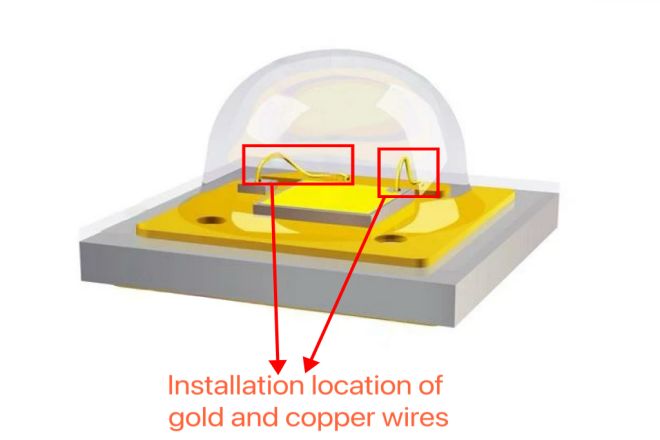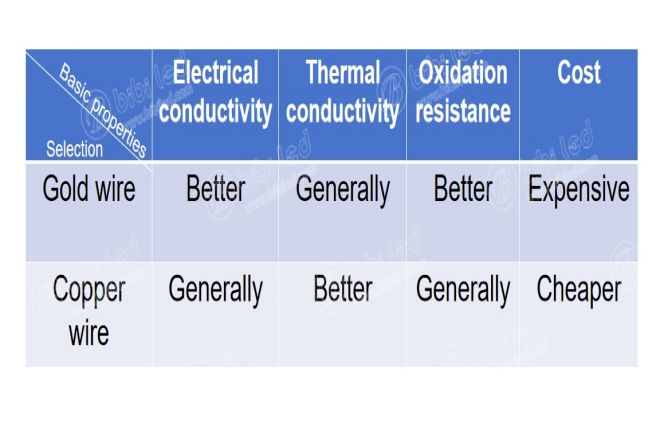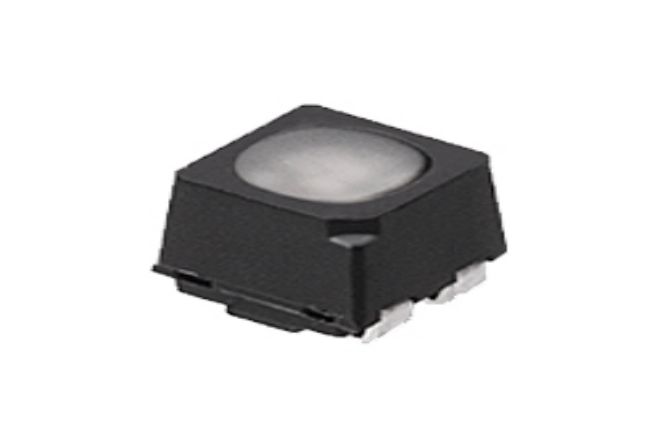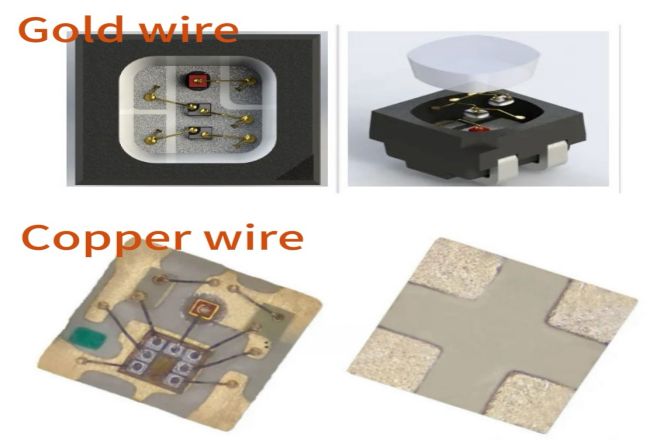介绍
1、LED显示屏金线和铜线用在什么地方?

金线与铜线在LED显示屏封装过程中起着至关重要的作用,主要用来连接LED芯片与支架,保证电流能够顺利地从外部电路传输到LED芯片,使其发光。
此连接工序不仅是LED封装的关键步骤之一,而且直接影响LED显示屏的性能、稳定性和寿命。
LED封装过程中,无论是用金线还是铜线连接,都需要精确的焊接技术和严格的质量控制。
焊接工艺的选择和参数的设定对连接质量和LED显示屏的性能有着重要的影响,同时封装材料的选择和封装工艺的优化也是提高LED显示屏性能的关键因素。
2.金线与铜线基本特性比较

在LED显示屏等电子设备的封装连接中,金线与铜线凭借其独特的物理化学性质,被广泛应用。下面就二者在导电性、导热性、抗氧化性、成本等方面进行详细的比较:
1). 电导率
- 金线:
金线以导电性能优异著称,电阻率极低,这意味着在电流传输过程中,金线可以更有效的降低电阻带来的能量损耗,保证电流稳定、高效的流向LED芯片,从而提高显示屏的亮度和发光效率。
- 铜线:
铜线也具有良好的导电性,但电阻率略逊于金线。
尽管如此,铜线在大多数应用场景下依然能够提供足够的电流传输能力,满足一般LED显示屏的发光需求。
2).热导率
- 铜线:
铜是优良的导热材料,其导热性能远胜于金线。
在LED封装中,良好的导热性能有助于将LED芯片产生的热量快速散发出去,防止芯片过热损坏,从而延长LED显示屏的使用寿命。
- 金线:
相比之下,金线的导热性能相对较差。
但由于金线在LED封装过程中主要起电连接作用而非散热作用,因此其导热性能对整体散热效果的作用有限。
在特定场景下,比如对电流传输要求较高,但对散热要求不高的应用,金线仍然是一种可行的选择。
3). 抗氧化性
- 金线:
金线具有极好的化学稳定性,不易与空气中的氧气或其它化学物质发生反应,因此具有极好的抗氧化和抗腐蚀性能。
此特性使得金线在恶劣的环境下也能保持稳定的电连接,确保LED显示屏的可靠运行。
- 铜线:
铜线虽然导电性良好,但是其化学稳定性相对较差,容易被空气中的氧气氧化。
氧化的铜线表面会形成一层氧化膜,导致电阻增大,导电性能下降,甚至连接失败。
因此,在使用铜线时,通常需要采取额外的保护措施(如镀金、镀银等)来防止氧化。
4). 成本
- 金线:
由于金是一种稀有且昂贵的金属,因此金线的成本相对较高。
这使得金线主要应用于对性能要求极高,且对成本不敏感的高端应用场景,例如高端LED显示屏,医疗设备等。
- 铜线:
相比之下,铜是一种相对丰富且价格低廉的金属,因此铜线的成本较低。这使得铜线成为一般应用场景中广泛使用的选择,例如户外广告牌、道路照明等。
3、LED显示屏金线与铜线应用分析
在LED显示屏封装过程中,金线与铜线是主要的连接材料,各自具有独特的优势与局限性,下面就两者在LED显示屏中的应用进行详细的分析:
1).金线封装
1.1).优点:
亮度高:金线具有优良的导电性能,可以保证电流稳定、高效的传输到LED芯片,从而提高显示屏的亮度。
故障率低:金线化学稳定性好,不易氧化腐蚀,能维持长期稳定的电连接,降低故障率。
寿命长:由于金线的优良性能,采用金线封装的LED显示屏使用寿命更长。
适用于高要求应用场景,例如 室内显示屏、汽车照明、医疗设备等对性能要求极高的场景,金线封装可以提供更好的性能和稳定性。
1.2).缺点:
- 成本高:金属于稀有且昂贵的金属,因此金线封装的成本相对较高,不利于规模化的成本控制。
2). 铜线封装
2.1).优点:
成本低廉:铜是一种比较丰富且成本低廉的金属,因此铜线封装成本较低,适合一般的应用场景。
导热性能好:铜线具有优良的导热性能,有助于快速散热,保护LED芯片免受高温损坏。
2.2).缺点:
导电性相对较差:铜线的导电性虽然也很好,但是和金线相比还是有一定的差距,可能会影响电流的传输效率。
易氧化:铜线的化学稳定性不如金线,容易被空气中的氧气氧化,影响导电性和连接稳定性。因此,在使用铜线时,需要采取额外的保护措施(如镀金、镀银等)。
工艺不稳定:铜线封装工艺相对复杂,而且稳定性可能受很多因素(如焊接质量、防护处理等)影响,进而影响显示屏的可靠性和寿命。
3). 应用场景分析
- 高端应用场景:
对于要求亮度高、故障率低、寿命长的LED显示屏,比如室内显示屏、汽车照明、医疗设备等,金线封装是比较合适的选择,虽然成本较高,但能保证显示屏的稳定性和性能。
- 一般应用场景:
对于成本敏感且对性能要求不是特别高的场景,例如 户外广告牌、道路照明、家居照明等,铜线包装是一种经济实用的选择。
通过采取适当的保护措施和过程控制,可以保证显示器的基本性能和可靠性。
4、LED显示屏用金线还是铜线怎么选择?

1). 应用场景
高端应用场景:对于性能要求极高的场景,例如室内显示屏、汽车照明、医疗设备等,金线封装虽然成本较高,但可以提供更好的性能和稳定性。
一般应用场景:对于户外广告牌、道路照明、家居照明等对成本敏感,且对性能要求不是特别高的场景,铜线封装是一种经济实用的选择。
2). 成本预算
金线:金线成本较高,适合预算充足,对性能要求较高的项目。
铜线:成本较低,适合预算有限,且对性能要求不是特别高的项目。
3). 长期维护
从LED显示屏的长期运行维护考虑,金线封装可能故障率更低,使用寿命更长,从而减少后期维护更换的成本。但这也需要考虑到金线封装前期投入较高。
4). 综合考虑
LED显示屏选择用金线还是铜线,应综合考虑以上因素,根据具体需求进行权衡,以下是简要的决策框架:
如果项目对LED显示屏的亮度、稳定性、寿命等要求极高,且预算充足的话,建议选择金线封装。
如果项目对成本比较敏感,对LED显示屏的性能要求不是特别高的话,可以选择铜线封装。
在选择过程中还应考虑供应商的工艺水平、产品质量、售后服务等因素,保证最终选定的LED显示屏满足项目要求并有良好的长期运行效果。
结论
综上所述,金线凭借优异的导电性能、抗氧化性能、长寿命等特点在高端应用市场占有一席之地,而铜线则凭借成本优势在一般应用场景中得到广泛应用。
金线与铜线在LED显示屏封装中各有优势,其选择需要根据具体的应用场景、性能要求、成本控制等多方面因素综合考虑。
最后,如果您想了解更多关于LED显示屏的知识, 请与我们联系。

